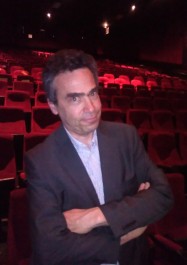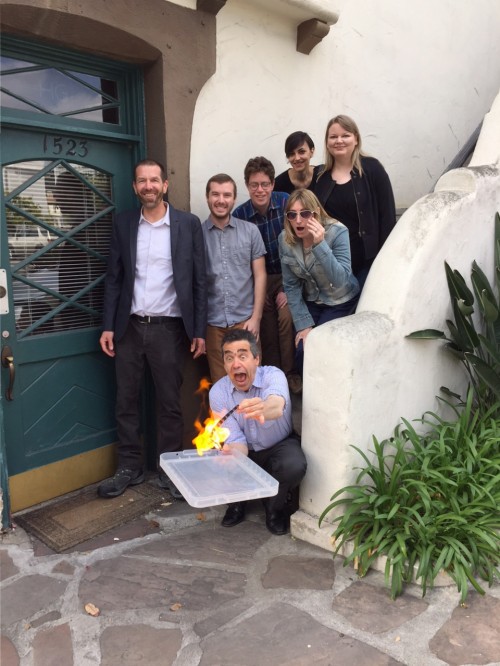
Serge Bromberg at the TCM Classic Film Festival
Last week, Flicker Alley sat down with Serge Bromberg, film preservationist and founder of Paris-based Lobster Films, before his presentation at the TCM Classic Film Festival on Friday, April 29, entitled “Amazing Film Discoveries.”
Bromberg is a natural showman, whether he’s providing live piano accompaniment to his film presentations or demonstrating how quickly nitrate film catches on fire, as he did outside the Flicker Alley office that morning. His joie de vivre comes out through his passion for finding and preserving film, a process he describes as “treasure hunting.”
Enjoy our exclusive interview, where Bromberg discusses his TCM festival presentations, the importance of music to film, the challenge of finding and restoring lost films, and more!
Your presentation today is called “Amazing Film Discoveries.” Could you tell us about what you are sharing today?
What I’m sharing today is the same thing I’ve been sharing for 25 years, which is the pleasure of discovering lost films. Half of the films shot during the history of cinema are now missing, for many reasons. So, if by any chance you come across a can of film that you know not to survive, then the idea of restoring it, then sharing it with people, is amazing. So, what I will be doing today mostly is showing stuff that did not exist before and that is now back alive. But of course I will disclose a few examples of what restoration means and what the result can be before and after, so you would think that this is a purely technological adventure—well, not at all. It’s like treasure hunting. And sometimes when you look for treasure, you find another treasure. That’s exactly what I’ll show, but I won’t say more at this moment.
When did you start presenting “Amazing Film Discoveries,” and how has your presentation changed over the years?
Well, the show is called “Retour de Flamme,” which would mean “Backfire.” Of course it deals with film flamme, which is nitrate film that burns so easily, as you know—as you’ve seen this morning.
The show actually started in 1992 in November, and the idea was very simple. We have cinema, we have someone who was willing at the time, a sponsor, to preserve a few films, so I thought, okay, let’s take the money of the preservation and make a few screenings. Because we didn’t have any money, I just sat at the piano and played it. And also because I didn’t want to cut into the leaders that are at the beginning and end of each film, I assembled the films on a big reel, leaving the leaders, and while the leaders were running through the projector, I would stand and tell the story of the next film or how it was discovered and what’s so special to know about it, in order to leave enough time for the projector to run the end of the leader and the beginning of the leader of the next film. So, that left about a minute between each film. And I instantly found out that it works very well.
So, now, over the years with the storytelling, piano, and of course, the digital technology that makes it possible to be much smoother, it has moved on and got a bit more complex, but eventually, it’s exactly the same thing: it ends up showing films you love to people you want to share them with.
You mentioned that you play the piano and you do live accompaniment, which you’ll be doing today. So, I wanted to ask you, as a musician who provides live accompaniment to silent films, what is the importance of the marriage between film and score, and what do you look for when you’re choosing composers for your films?
Well, first of all, there never was film shown in silence. For one good reason: when you show film in silence, if someone issues a comment, everyone will listen to it. And if the comment is bad, then, eventually, everyone will start saying bad things about the film. So they cover any hushing or coughing or whatever with music. And, of course, in real life you have a soundtrack, which is the noise that you have around you. So, let’s say that the music is a stylized soundtrack of what is on the screen, so you don’t have the feeling that you’re missing something.
Now, at the same time, there are different policies. Some people want to be a bit [of a] show-off—do music like, “Hey, listen to my music! Don’t watch the film! Here is my music!” I’m not at all this kind of guy. I’m improvising for each film. And when I improv, I like not to be a disservice to the film. What I’m doing is basically being the middleman between the film and the audience. If the audience is not playing the game, then playing the piano becomes almost impossible. It’s an experience that every cinema pianist has had in his life, where you play the piano in front of a good audience which is silent, but you know that there is good energy, and then you’re carried by it because you know that the audience is with you and the music is good. Well, on the other hand, sometimes the audience is “not there”—the silence is the same, but the energy is really bad, and you try to overdo everything to kind of “make it happen,” and the more you do things, the less it works. So, that’s why silent film playing is like a live show. Every time it’s different. And of course, it’s total improv. So, I never play twice the same thing.
What you said about music reminds me of an anecdote. I heard that a director said he wanted to have his film completely without music. His reasoning was that “it’s more realistic.” And the composer said to him, “If it’s so realistic, where’s the camera?” In real life, there is no camera. Once you put a camera there, you need music to help. [Note: The anecdote involves Alfred Hitchcock and film composer David Raskin, regarding the 1944 film Lifeboat.]
That’s absolutely correct. Filming, editing is stylization. There’s a mediation between the story, actors, sets, directing, storytelling—it’s not natural. And plus, when you have a card say, “A few days later…” In real life, you have to wait a few days before it becomes a few days later.
Tomorrow you are doing a Club TCM presentation featuring a “special world premiere surprise.” Is there anything you can reveal about that?
Yes, very easily. Except I don’t remember what it is. I think it’s the world premiere of a lost Stan Laurel solo comedy called The Whole Truth that was found last year and never shown. Made, I think, in 1922. What is so funny is that it’s a film that was a 10-minute reel, the kind of reel that you film when you have a week to deliver a finished product, but you don’t have the time and you don’t have the money. So, they actually used a phony story to include in the film outtakes from other films that had not been used. So, it’s a bit bizarre because you see the settings, the props of other films that have survived that are all included in scenes that do not exist in the films that survived before. It’s really interesting.
Along with David Shepard, you helped to restore the 1925 The Lost World, which we offer as a Manufactured-On-Demand DVD. What are your future plans for this title?
Well, the future plans for this title are very easy. We want to restore it again, in 2- or 4K, well, mostly 2K, based on the best surviving elements. We found new material since our last restoration in 2000, which of course, made the old version totally obsolete. So, we reconstructed the film. We had two musicians, Jeff Mills and Robert Israel, compose two new scores, plus we’ll have the old score by Alloy Orchestra—we’ll have three scores—we’ll have a lot of extras that no one has ever seen. But unfortunately, or fortunately, at the last moment you can arrive with new footage. So, at this moment, we’ve put a hold on the reconstruction, because we may need to work a bit more. Nevertheless, that’s where we are standing at the moment.
And will this be on Blu-ray?
Oh, I guess it’ll be on Blu-ray, with a company called—what’s the name of this company—called Flicker something—I can’t remember.
The main feedback we’ve gotten from our audience about Marcel L’Herbier’s L’Inhumaine is that it holds up so well, that it remains avant-garde and exciting even by today’s standards. Can you tell us a little bit about why you think that is and about how you went restoring this incredible 4K edition?
Well, we went restoring it because I’d been willing to do L’Inhumaine for years, for maybe 25 years, and we’d been speaking with Marie-Ange L’Herbier, the daughter of Marcel L’Herbier for 25 years. Then a moment comes—you never know why—but then all of a sudden, a moment comes and you say, “Well, why not now?” The big issue was that no restoration really happened from the camera negative with the original tints that were supposed to be lost, but they were actually in the camera negative, and there was no music… So, basically, that restoration needed a producer. So, that’s what we did: find some money, overview the restoration—do the restoration ourselves for the image—produce the recordings, do the coordination—with Arte, with Flicker, of course—historical fact checking, and everything… Basically, what we do when we produce a restoration is we start from scratch, and we get the film back on its feet, do everything as well as possible. That’s what we’ve done, with Flicker’s help, I must admit.
The documentary that you directed, Henri-George Clouzot’s Inferno, pieces the puzzle together of what went wrong on Clouzot’s unfinished film Inferno. Can you speak about the experience of solving this mystery for film audiences? And how do you feel this relates to the broader matter of rescuing, restoring and preserving films for the future?
Well, actually, it is not at all restoring; we found elements that were in very good shape because they had never been used. What we did is basically produce a film based on that unused footage, about a film that was never completed. Now, it’s more an experience in film directing and documentary directing—although it’s not really a documentary—than film restoration as it is. We’ve created a lot of elements, including music, some dialogue… we had very little to work from. We hired new actors, including Bérénice Bejo, who was the actress in The Artist, and other people—that was before The Artist—and basically we tried to reconstruct this unique moment of a film that was never to be. So, it is not “restoration” in any event, but it’s treasure hunting and treasure finding at its best.
And if you have some more time, if you want to speak on a general level about what are some of the challenges of finding and restoring lost films and what has been the most fulfilling aspect of this endeavor?
Well, searching for films is like a drug. It’s like [being] a treasure hunter. You never know what treasure you’ll find. You want to go for more. You know there are more treasures to be found out there. That’s step number one. Then, step number two: once you become a bit older—I’m in my 50s, and I’ve known since I was probably 10—so that’s 40 years of film hunting—you realize that the most important [thing] is not film hunting. The most important [thing] is audience hunting. Because a film only exists in the moment it is shown to someone, whether it be through DVD, television, streaming, theatrical, whatever… Blu-ray.
So, the most fulfilling experience is certainly to take a film from darkness—for example, The Battle of the Century, the Laurel and Hardy film that you’re going to see today. I mean, I’m 55—the film was lost for the last 70 years—so I thought I would never see it. I mean, the fact that I would find it, with the help of Jon Mirsalis—who is actually the discoverer of the film—and restore it and show it here, of course, is a big fulfillment. Same as the color version of A Trip to the Moon and many, many others.
But, beyond that, I must say that the best moment is when you climb the stairs—the best moment is when the Christmas presents are untouched and still wrapped in their paper—the best moment is before the thing is happening. Because you know it will happen. It may be disappointing or not, but at least you will live a new experience. So, when you arrive and have cans of films without titles—everything rusty—from the ‘20s or the teens, and then you think, “Oh, well, think of how many Méliès films or lost Charlie Chaplin films that may be there!” That’s probably the best moment. Maybe not fulfilling, maybe a bit [of a] selfish moment, but that’s a unique moment in your lifetime when you’re the only one—when you’re promised with the next one—to open the cans and find out what’s there. That’s a privilege.

